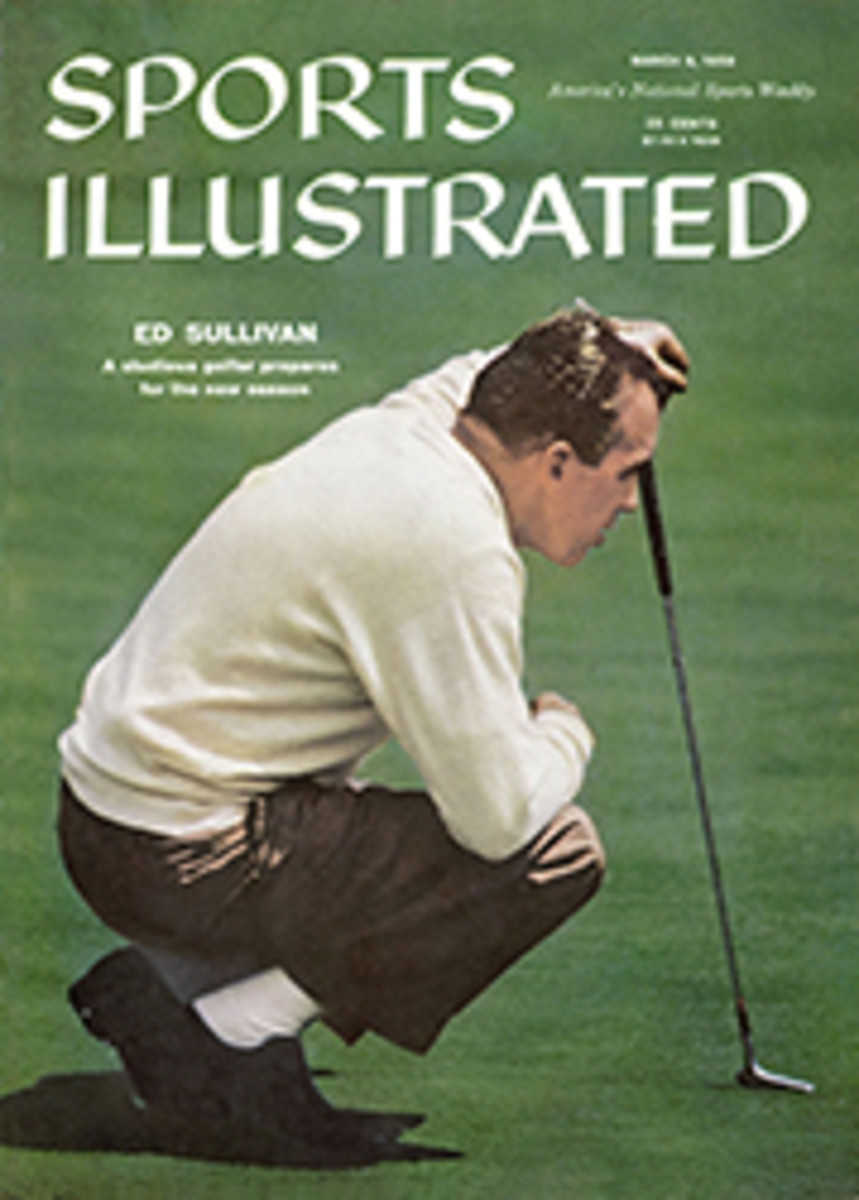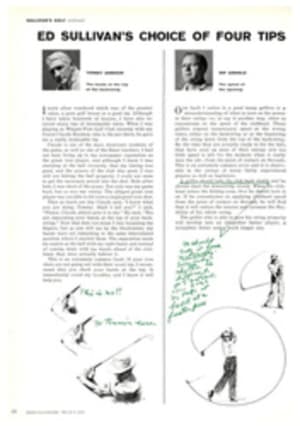
ED SULLIVAN'S CHOICE OF FOUR TIPS FROM THE TOP
TOMMY ARMOUR
The hands at the top of the backswing
I have oftenwondered which was of the greater value, a good golf lesson or a good tip.Although I have taken hundreds of lessons, I have also received many tips ofinestimable value. When I was playing at Winged Foot Golf Club recently with myfriend Claude Harmon, who is the pro there, he gave me a really invaluabletip.
Claude is one ofthe most observant students of the game, as well as one of the finest teachers.I had not been living up to my newspaper reputation as the great iron player,and although I knew I was standing at the ball correctly, that my timing wasgood, and the groove of the club was good, I was still not hitting the ballproperly. I could not seem to get the necessary punch into the shot. Hole afterhole, I was short of the green. Not only was my game hurt, but so was myvanity. The alleged great iron player was not able to hit even a single goodiron shot.
Then at lunch oneday Claude said, "I know what you are doing, Tommy. Shall I tell you?"I said, "Please, Claude, please give it to me." He said, "You areseparating your hands at the top of your backswing." Now that does not meanI was loosening my fingers, but as you will see by the illustration, my handswere not remaining in the same interrelated position where I started them. Theseparation made me snatch at the ball with my right hand, and instead of comingdown with my hands ahead of the clubhead, they were actually behind it.
This is anextremely common fault. If your iron shots are not going out with their usualzip, I recommend that you check your hands at the top. It immediately cured mytroubles, and I know it will help you.
RIP ARNOLD
The speed of the upswing
One fault Inotice in a good many golfers is a misunderstanding of when to turn on thepower in their swing—or, to say it another way, when to concentrate on thespeed of the clubhead. These golfers expend unnecessary speed at the wrongtimes, either on the backswing or at the beginning of the swing down from thetop of the backswing. By the time they are actually ready to hit the ball, theyhave used up most of their energy and too little speed is left for the momentwhen it really does the job—from the point of contact on through. This is anextremely common error and it is observable in the swings of many fairlyexperienced players as well as beginners.
A golfer shouldtake the club back slowly* and he should start the downswing slowly. When hisclubhead enters the hitting area, then he should turn it on. If he concentrateson applying clubhead speed from the point of contact on through, he will findthat it will reduce the tension and increase the flexibility of his wholeswing.
The golfer who isable to pace his swing properly will develop into an altogether better player,a straighter hitter and a much longer one.
*He should take it back naturally. Everybody's rhythm is different. It'snatural; for some to take it back faster.
BILL GORDON
The friendly grip
A good golfer isrecognized by his grip. Rightly so, for a proper grip is the basis for at least60% of a man's swing. Beginners, and players who are uncertain of their game,tend to grab the club and hang on like grim death, or else they hold the shaftgingerly as if they were afraid of the damage they might inflict on the ball.Both excesses can throw you off your game. Whenever I see a pupil's fingernailswhitening as he holds the club, I ask him to let go for a minute and shakehands with me. Usually he gives me a nice firm "friendly" grip, andthat's just what I want—not a bone-crusher or a limp paw. Once we've shakenhands, I ask him to grip his golf club the same way, firmly but in a friendlyway. His execution of shots usually improves.
I always check tosee that my pupils' hands are set properly on the shaft—that goes withoutsaying—but what I am trying to bring out here is the importance of grippingwith the right amount of pressure**. To the beginner, the golf grip feels atfirst like the most unnatural thing in the world, but he will soon find outthat only through practicing the correct grip can he control with any degree ofsteadiness the arc of the club and the flight of the ball. Repetition of theright grip will result, in due course, in confidence and a well-founded swingthat will bring good results regularly. Give the friendly grip a try.
**The secret in 7 words
WILLIEHUNTER***
Chipping from traps
Many golfers makethe sand trap shot more difficult than it has to be. This is because they weretaught that the only way to come out of a trap is with an explosion shot, arather unnatural stroke for the beginner since the clubhead has to strike thesand behind the ball and does not strike the ball itself.
There are anumber of occasions when the lie of the ball and the lay of the land makeplaying an explosion shot unnecessary and even unwise. Whenever the bank of thetrap is low and there is enough putting surface between the trap and the hole,a golfer would be more sensible to play a variation on a chip shot-with theclubhead contacting the ball cleanly and lofting it onto the green. Allow forsome roll.
A chip from thesand is played the same, as a chip from any other lie, with two modifications.First, you grip the club low on the shaft, as far down as the bottom of theleather if this is comfortable. Second, glue your eyes on the left half of theball rather than on the right half as you do on ordinary shots. This enablesyou to deliver a clean, descending blow, and that is the essence of all chipshots.
***Nobody ever plays these shots with greater skill + delicacy than my friendWillie.
FOUR PHOTOS
ILLUSTRATION
This is me!!
ILLUSTRATION
No tension here
ILLUSTRATION
A very delicate shot -- wrists andhands completely free of tension -- this shot is an acid test of your freedomfrom tension
FOUR ILLUSTRATIONS

